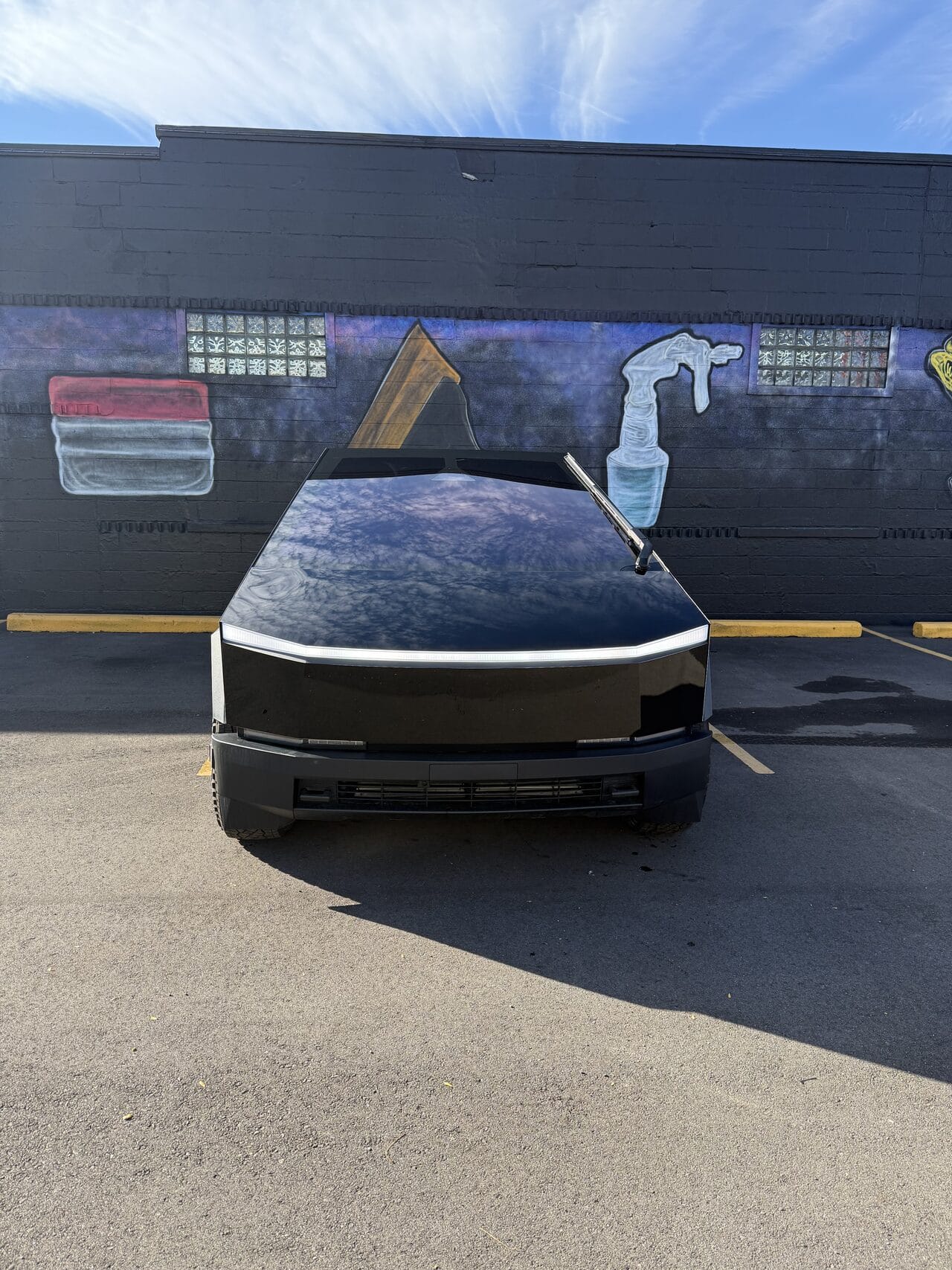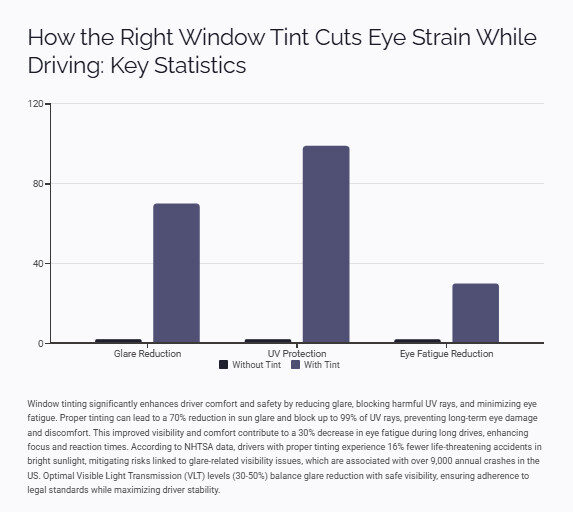Long-distance driving often places heavy demands on the eyes. Between bright sunlight, reflective road surfaces, and constant focus adjustments, drivers may experience significant visual fatigue. This fatigue, known as eye strain, can reduce alertness and make journeys more stressful than they need to be.
Window tinting has emerged as a trusted way to reduce glare and visual discomfort. By filtering light and cutting down on brightness, certain types of tinting allow drivers to maintain clearer vision. Understanding which tinting options are most effective requires a closer look at causes of eye strain, available film types, and the science behind glare reduction.

Understanding the common reasons behind driver eye strain
What causes drivers to experience eye strain on roads?
Driving involves continuous concentration on a moving environment, which naturally challenges the eyes. Rapid transitions from bright to dim areas force the eyes to refocus repeatedly, leading to muscular strain. Windshield reflections can intensify this stress, leaving eyes dry and sore. Over time, these factors combine to make long drives physically demanding for vision.
The role of excessive sun glare in causing strain
Glare occurs when intense light overwhelms the eye’s ability to adjust. Road surfaces, water, and car windows reflect light directly into the driver’s field of vision. This not only causes squinting but also reduces visibility of surrounding objects. Prolonged exposure to glare can make eyes feel heavy and strained. For drivers, this is both uncomfortable and potentially dangerous.
How prolonged driving conditions intensify discomfort further
During extended trips, eyes have little opportunity to recover from brightness exposure. The combination of natural light, headlight beams, and dashboard displays creates a relentless cycle of adjustment. Muscles within the eye must contract and relax continuously. The absence of breaks makes fatigue unavoidable. This is why longer drives often leave drivers with more intense discomfort compared to short commutes.
How window tinting plays a role in reducing strain
Why window tinting helps drivers stay more comfortable
Window Tinting Dearborn moderates the level of light entering the vehicle. By creating a balanced illumination inside the cabin, it reduces the extreme contrasts that cause discomfort. Instead of squinting, drivers enjoy softer, more natural light. This allows the eye muscles to remain relaxed even when external conditions fluctuate. Over time, this results in less accumulated fatigue.
Connection between window tinting and vision health overall
Tinting not only improves comfort but also acts as a safeguard for eye health. Films designed with UV filters block harmful radiation that accelerates eye aging. This reduces risks of long-term conditions such as cataracts and macular degeneration. Protecting eyes from harmful rays ensures healthier vision across years of driving. Thus, tinting contributes both to immediate relief and lasting well-being.

Exploring different types of window tinting materials
Characteristics and limitations of dyed window tint
Dyed films absorb sunlight using a dye layer, which helps reduce visible brightness. Their affordability makes them widely available for everyday drivers. However, they offer limited UV and heat rejection compared to advanced materials. Over time, exposure to sunlight causes the dye to fade, reducing effectiveness. For long drives, this option may provide short-term relief but not lasting comfort.
Performance features of metalized window tinting films
Metalized films incorporate small metallic particles that reflect sunlight away from the cabin. This reflection reduces both glare and heat buildup inside the vehicle. They are durable and resistant to fading, offering stronger performance than dyed films. However, a drawback is the potential interference with GPS, mobile signals, and radio reception. For drivers relying on technology, this can become a limitation.
Advantages of carbon-based automotive window tint
Carbon films are valued for their high durability and consistent performance. They block infrared light effectively, preventing interior heat while reducing glare. Their matte finish also limits reflective surfaces, creating a comfortable driving view. Unlike metalized tint, they do not disrupt electronic signals. For drivers prioritizing long-term reliability and visual ease, carbon provides a strong balance of features.
Why ceramic window tint are considered the best option
Ceramic films use non-conductive particles that provide superior glare reduction and UV protection. They block up to 99% of ultraviolet rays while maintaining exceptional clarity. Importantly, ceramic films retain visibility during nighttime driving, making them versatile for all conditions. Their advanced technology ensures both immediate comfort and long-lasting health benefits. Many drivers regard ceramic as the top standard for eye protection.
Key features that influence eye comfort on long trips
Importance of visible light transmission levels in tint
Visible Light Transmission (VLT) describes the percentage of light passing through the window film. Films with too low VLT levels may darken the view excessively, straining the eyes at night. Conversely, films with high VLT allow too much brightness, reducing daytime benefits. The optimal range, usually between 35% and 50%, balances comfort and safety. This range reduces glare while maintaining adequate visibility.
How ultraviolet protection directly impacts eye health
Ultraviolet rays penetrate through glass and can damage delicate eye tissues over time. Prolonged exposure increases risks of disorders such as cataracts and retinal damage. Window films with high UV rejection help filter these harmful rays effectively. This reduces cumulative stress on the eyes and protects long-term vision. Such protection is particularly valuable for drivers spending hours on highways.
Role of heat rejection in reducing driver fatigue
Excessive heat inside a car contributes to physical exhaustion and slower reaction times. Films with strong infrared rejection keep cabin temperatures lower, reducing stress. Cooler interiors mean less need for air conditioning, leading to more consistent comfort. Lower fatigue levels allow drivers to maintain alertness longer. This indirectly reduces eye strain by easing the overall driving experience.
Comparing the effectiveness of different tinting choices
Best window tinting options for bright daytime driving
During sunny highway trips, glare from the road and surroundings can be overwhelming. Carbon and ceramic films are especially effective at minimizing this brightness. Their balanced VLT levels provide clearer vision without forcing the eyes to adapt constantly. These films also prevent heat buildup, which can worsen fatigue. For daylight conditions, they outperform dyed and metalized alternatives.
Most effective tinting films for night driving safety
Night driving requires films that balance glare reduction with clear visibility. Ceramic films excel here because they block distracting headlight glare while maintaining clarity. Unlike darker films, they do not excessively dim the view of the road ahead. This balance reduces the risk of night blindness while enhancing focus. Drivers can remain confident and comfortable even in low-light conditions.
How legal tint limits affect safety and eye comfort
Regulations on tint darkness vary by state and exist to protect road safety. Films that exceed legal VLT limits may compromise visibility at night. While darker tint might seem appealing, they can lead to more strain instead of less. Staying within legal ranges ensures both compliance and safe driving vision. Balancing comfort with regulation avoids unnecessary risks.
Scientific explanation of glare reduction through window tinting
How tinting reduces glare to prevent eye strain
Glare occurs when light intensity exceeds the eye’s capacity for adaptation. Window films counter this by filtering and diffusing incoming rays. Instead of direct beams, drivers experience moderated, evenly distributed light. This lowers the need for constant squinting and adjustment. The result is smoother vision and less overall fatigue during extended drives.
The role of polarized films in reducing reflections
Polarized technology targets reflective glare from surfaces like asphalt, glass, or water. By blocking horizontally oriented light waves, these films mimic the function of polarized sunglasses. Drivers benefit from a clearer and steadier view with fewer distractions. This technology is particularly effective for rainy or highly reflective conditions. Reduced reflections mean reduced strain and safer long-distance travel.
Why drivers in regions like Dearborn often choose tinting
Driving conditions in Dearborn that increase eye stress
Cities with diverse weather patterns, such as Dearborn, present unique visual challenges. Drivers face bright summer days, snowy reflective winters, and long highway commutes. Each of these conditions increases glare exposure and strain. In such environments, solutions that reduce brightness become essential. Window tinting provides relief across seasonal changes, making it valuable for everyday drivers.
How local adoption of window tinting supports comfort
In regions where long drives are common, many vehicle owners turn to tinting for relief. The consistent use of films reduces glare across varying conditions. As more drivers adopt advanced films, safer roads and fewer fatigue-related issues result. Local adoption reflects the practicality of tinting in real driving environments. It has become a standard tool for maintaining comfort and vision clarity.
Maintenance practices to ensure long-term tinting effectiveness
How proper cleaning improves clarity and visibility
Films can lose performance when covered with dirt, smudges, or scratches. Cleaning with microfiber cloths and ammonia-free solutions helps preserve clarity. Avoiding abrasive materials prevents damage that could distort vision. Regular care ensures films maintain their filtering abilities effectively. This simple practice directly contributes to reduced eye strain during every drive.
When to consider replacing or upgrading window films
Over time, tint may fade, bubble, or peel due to exposure and aging. Such issues reduce their ability to block glare and protect eyes. Replacing old films restores maximum performance and safety. Upgrading to advanced technologies, such as ceramic, can further improve comfort. Timely replacement ensures long-term protection and consistent driving ease.
TintedAF Serving the Warren Ave Community and Beyond in Detroit, MI
TintedAF is dedicated to serving the diverse needs of the local community of Detroit, MI, including individuals residing in neighborhood like Warren Ave Community. With its convenient location near landmarks such as the Ford Woods Park, Fairlane Town Center, Islamic Center of America, Henry Ford College and major intersections like W Warren Ave & Evergreen Rd and Mercury Dr & Southfield Fwy (M-39) (coordinates: 42.33351622555768, -83.21166862598376), we offer window tinting services.
Get window tinting Services at Warren Ave Community Now
Navigate from Warren Ave Community to TintedAF Now
How the Right Window Tint Cuts Eye Strain While Driving: Key Statistics
Glare Reduction:
- Window tinting can reduce sun glare by up to 70%, significantly lowering eye strain and discomfort.
- Drivers experience 16% fewer life-threatening accidents in bright sunlight conditions with proper tinting (NHTSA data).
UV Protection:
- Quality tint block up to 99% of harmful UV rays, protecting eyes from cataracts, glaucoma, and long-term damage.
- Untinted windows allow significant UV exposure, increasing risk of eye diseases and premature aging.
Driver Comfort & Safety:
- Reduced glare leads to 30% less eye fatigue during long drives, improving focus and reaction times.
- Over 9,000 annual crashes in the US are linked to glare-related visibility issues; tinting helps mitigate this risk.
Visible Light Transmission (VLT) Impact:
- Optimal tint levels (around 30-50% VLT) balance glare reduction and safe visibility, enhancing driver stability and comfort without compromising legal standards.
[Visual: Bar chart comparing glare intensity, UV exposure, and eye strain levels with and without window tinting]

Summary of Key Takeaways
The right window tinting choice can make long drives far less demanding on the eyes. By reducing glare, blocking UV rays, and keeping light levels balanced, tinting supports both comfort and safety. Drivers who choose carefully benefit from clearer vision, less fatigue, and healthier eyes over time.
Frequently Asked Questions
Q1: What type of window tinting is safest for night driving?
Ceramic tint with medium VLT levels are safest for night conditions. They cut glare from headlights while preserving clear visibility.
Q2: How does window tinting help prevent long-term eye problems?
Tinting blocks harmful UV rays, which contribute to cataracts and other vision disorders. It reduces long-term damage caused by repeated sun exposure.
Q3: Why is visible light transmission important in choosing tint?
VLT determines how much light enters the vehicle. The right balance reduces glare in the day without limiting night visibility.
Q4: Do all types of tint provide UV protection for eyes?
No, dyed films offer limited UV protection, while ceramic and carbon films block nearly all harmful rays effectively.
Q5: How often should drivers replace their window tint?
Most films last between five and ten years. Replacement is necessary once fading, bubbling, or peeling reduces effectiveness.
Our Other Blog Posts Related Window Tinting
Why Daily Commuters Should Consider Window Tinting For Skin
Why Window Tinting Protects Drivers From Harmful UV Rays
Why Window Tinting Improves Privacy Without Blocking Visibility

